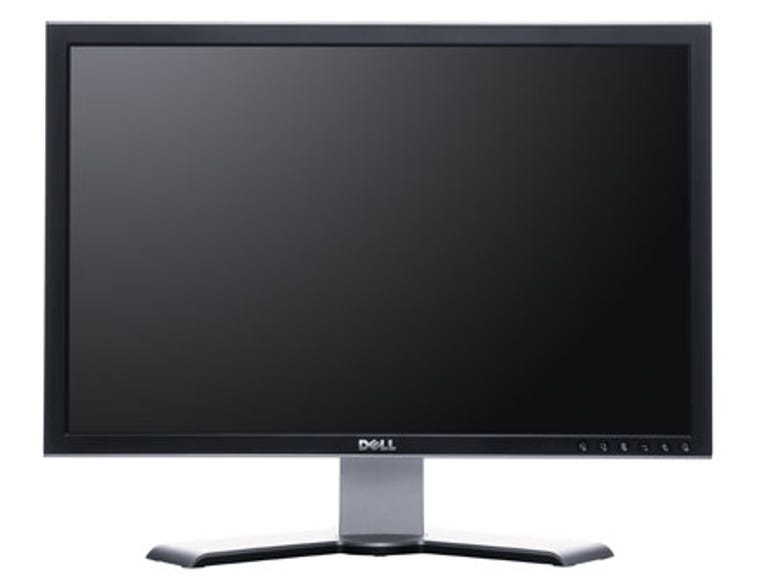 Why You Can Trust CNET
Why You Can Trust CNET Dell 2407WFP-HC review: Dell 2407WFP-HC
Dell has provided an excellent revision to its 2407 series, at an amazing price point. The only reason we can come up with not to buy it is if you desperately need 1080p over component.
Dell's 2407WFP-HC is the sixth model in the 2407 series. The first few revisions were known for an unfortunate tendency to display fuzzy text and mess up gradients due mainly to the image post-processing engine used. This was eventually reduced to just vertical gradients being a problem, and then all image quality concerns were addressed with the fifth revision.
The Good
The Bad
The Bottom Line
The sixth "HC" revision increases the image quality once more by bringing High Colour to the table, meaning the screen is capable of displaying 92 percent of the NTSC colour gamut, compared to the 72-76 percent of old. For the non colour geeks out there, this means that a lot of colours that were being "lost" on older monitors -- that is, being displayed inaccurately -- can now be seen on screen. This should please everyday users and amateur photographers alike, although colour professionals will probably still keep a properly calibrated CRT somewhere for safety.
Features
Dell's 24-inch monitors are typically the most feature laden of the bunch, with a stellar stand that supports height, tilt, pivot and rotate adjustments. A card reader is featured on the side that supports CF, SM, SD, MS and MMC, which connects to the PC through USB. Don't worry about losing USB ports though, as four extra are on the monitor -- two on the side, and two on the bottom.
Five different video inputs are available: DVI, VGA, Component, Composite and S-Video. It supports Picture In Picture and Picture By Picture using DVI or VGA as a base, and your choice of Composite, Component or S-Video as the secondary image. For those who've thrown their life savings into a PS3, an HDMI to DVI cable is included, and since HDCP is supported you'll be playing games and watching Blu-Ray movies with ease.
The 2407WFP-HC uses a Samsung S-PVA panel. As a VA panel it brings good colours, blacks, contrast, viewing angles and a decent response time so that moving images are less likely to ghost. There are two alternatives to VA -- IPS panels can provide superior colour reproduction and viewing angles but at a high cost, while the cheap TN ones offer faster response times at the sacrifice of image quality and viewing angles -- so in essence VA is a compromise between the two.
Die hard gamers may complain of input lag on VA monitors, a phenomenon that creates a small delay between when the monitor receives the image and actually displays it (thanks to image post processing of some variety, usually response time acceleration, copy protection or image enhancements). The upshot of this is when someone moves a mouse, this is reflected on screen a fraction of a second later rather than instantaneously. As a consequence, competitive gamers with twitch reaction times usually prefer IPS screens that don't suffer from this effect. In practice we didn't notice this and found the 2407WFP-HC to be stellar for gaming and highly immersive, but if you're susceptible to this phenomenon you may want to try before you buy.
Design
Dell's aggressive futuristic design is a winner here. The base is strong and heavy enough that it doesn't shift around while manipulating the monitor, and the aforementioned stand adjustments are leader-class. The menu is easy enough to navigate (although the arrangement can feel a little unwieldy at times), the buttons functional and easy to access. All the inputs are tucked away at the back of the screen itself, and a hole is included in the middle of the stand to keep cables tidy.
In terms of secondary inputs, Component works fine but only up to 1080i, which due to the lack of deinterlacing filters can look more than a little rough -- so if you've got a choice in resolutions (ie Xbox 360 owners), for image quality you're best off sticking to 720p. 1080p is not supported, quite possibly down to HD content providers' insistence on killing analog connections in favour of HDCP encrypted digital ones.
DVI can handle the full 1080p resolution, and armed with an HDMI > DVI cable and a PlayStation 3 everything was merry after a few required colour adjustments, the monitor allowing us to set a 1:1 ratio so the image didn't stretched to the default 1920x1200 size. Technically the DVI connection on the monitor is not meant to support 1080i, however you can enable this through the service menu by turning the iTest feature on if you really need to.
Dell has provided an excellent revision to its 2407 series, at an amazing price point. The only reason we can come up with not to buy it is if you desperately need 1080p over component -- in which case you could turn to the BenQ FP241WZ. Otherwise if you're in the market for a 24-inch, you really can't ignore this one.


